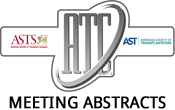2017 American Transplant Congress
High Regulatory T Cells Rate Early After Lung Transplantation Is Associated with Bronchiolitis Obliterans Syndrome Development.
Despite treatment improvement, the bronchiolitis obliterans syndrome (BOS) affects more than 50% of the lung-transplant recipient in the 5 years post-transplantation and because it cannot…2017 American Transplant Congress
Lymphotoxin (LT) β Receptor-Mediated Non-Classical NFκB Signaling in Lymphatic Endothelial Eells (LEC) is Required for Homeostatic T Cell Migration.
Background: The selective recruitment of regulatory T cells (Treg) or blockade of memory/effector T cell migration to the graft and draining lymph nodes (dLN) are…2017 American Transplant Congress
CMV-Specific CD4+ T Cells in CMV-IgG-Seronegative Individuals Protect from CMV Viremia Following Transplantation with a CMV-Seropositive Donor Kidney.
Internal Medicine, Nephrology and Transplantation, Erasmus Medical Center, Rotterdam, Netherlands
A primary infection with cytomegalovirus (CMV) is one of the major threats following transplantation of a CMV-IgG-seropositive donor organ into a CMV-IgG-seronegative individual. Therefore, prophylactic…2017 American Transplant Congress
CD4+CD28null T Cells Require IL-15 & IL-21 to Become Alloresponsive.
IntroductionAgeing and a pro-inflammatory milieu, such as present in patients with end-stage renal disease, are important drivers of increased T-cell differentiation, which is accompanied by…2017 American Transplant Congress
Baseline Immune Assessment to Individualize Immunosuppression in SPK Recipients with Type 1 Diabetes.
Introduction:Type 1 diabetes (T1D) is an immune-mediated disorder associated with multiple immunological anomalies. Immunologic abnormalities might help to explain why recipients of simultaneous pancreas kidney…2017 American Transplant Congress
FcγRIIB-Mediated Coinhibition Attenuates Donor-Reactive CD8+ T Cell Responses.
Emory Transplant Center, Emory University, Atlanta, GA
Memory T cells can be a formidable barrier to long-term, rejection-free allograft survival, particularly in the setting of costimulation blockade. Ongoing work in the field…2017 American Transplant Congress
Fate and Function of CD8+ T Cells Primed by Fetal Antigen During Pregnancy.
Background The long-term fate of maternal T cells primed by fetal antigen during pregnancy has not been well studied but may have significant impact for…2017 American Transplant Congress
CD4 and CD8 T Cells: Respectively Reprogrammed and Recapitulated in the Neonate to Induce Transplant Tolerance.
Alberta Transplant Institute, University of Alberta, Edmonton, Canada
Purpose: Non-conditioned neonatal mice develop acute graft-versus-host disease (aGVHD) when injected with adult allogeneic spleen and bone marrow cells (allo-SC/BMC). To prevent aGVHD and induce…2017 American Transplant Congress
High CTLA-4 Expression and Diminished FOXO3 Expression Underlie Differential CD28 Signaling on Human Memory Th17 Cells.
Pathogen primed memory T cells can cross-react with allogeneic antigen and mediate graft rejection, a process termed allogeneic heterologous immunity. Th17 cells are pro-inflammatory CD4+…2017 American Transplant Congress
Myeloid-Derived Suppressor Cells (MDSC) Accumulate in Intestinal Transplant (IT) Recipients (rc) and Suppress Recipient T-Cell (T) Response Against Donor Antigen.
[Introduction] Recent advances of immunosuppressive regimens have decreased rejection rate and improved rc survival of IT. MDSC are potent immature myeloid cells capable of suppressing…
- « Previous Page
- 1
- …
- 33
- 34
- 35
- 36
- 37
- …
- 53
- Next Page »
